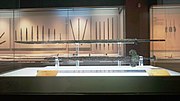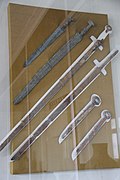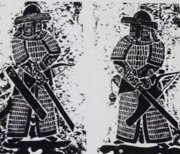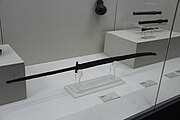This is a list of types of swords.

The jian is a double-edged straight sword used during the last 2,500 years in China. The first Chinese sources that mention the jian date to the 7th century BCE, during the Spring and Autumn period; one of the earliest specimens being the Sword of Goujian. Historical one-handed versions have blades varying from 45 to 80 centimeters in length. The weight of an average sword of 70-centimetre (28-inch) blade-length would be in a range of approximately 700 to 900 grams. There are also larger two-handed versions used for training by many styles of Chinese martial arts.

Dao are single-edged Chinese swords, primarily used for slashing and chopping. They can be straight or curved. The most common form is also known as the Chinese sabre, although those with wider blades are sometimes referred to as Chinese broadswords. In China, the dao is considered one of the four traditional weapons, along with the gun, qiang (spear), and the jian, called in this group "The General of Weapons".
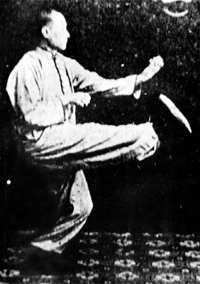
Eagle Claw is a style of Chinese martial arts known for its gripping techniques, system of joint locks, takedowns, and pressure point strikes, which is representative of Chinese grappling known as Chin Na. The style is normally attributed to the famous patriotic Song dynasty General Yue Fei. Popular legends states that he learned martial arts from a Wudang Monk named Zhou Tong and later created Eagle Claw to help his armies combat the invading armies of the Jin dynasty. It was passed down until the Ming dynasty. Thus, the style took on long range strikes and aerial jumps. During the Qing dynasty, the military instructor Liu Shi Jun became known as the modern progenitor of Eagle Claw and taught many students. His student Liu Cheng You later taught Chen Zizheng who was invited to teach the style in the prestigious Chin Woo Athletic Association during the Republican era. The style spread as Chin Woo opened sister schools in other provinces. Today, it is practiced around the world.

The Baiyue, Hundred Yue, or simply Yue, were various ethnic groups who inhabited the regions of Southern China and Northern Vietnam during the 1st millennium BC and 1st millennium AD. They were known for their short hair, body tattoos, fine swords, and naval prowess.

The zhanmadao was a single-bladed anti-cavalry Chinese sword. It originated during the Han dynasty and was especially common in Song China (960–1279).
Ou Yezi was a legendary master of sword-making in the Spring and Autumn period. According to Yuejueshu, he forged five treasured swords for Gan Jiang and King Zhao of Chu, named, respectively, Zhanlu (湛卢), Juque (巨阙), Shengxie (胜邪), Yuchang (鱼肠) and Chunjun (纯钧). He also made three swords for King Goujian of Yue, named Longyuan (龙渊), Tai’e (泰阿) and Gongbu (工布), Hailed as The Greatest Blacksmith.
Gan Jiang and Mo Ye were a swordsmith couple, discussed in the literature involving the Spring and Autumn period of Chinese history. Some aspects of this material may be considered historical; others are certainly mythological. A pair of swords was forged by and named after them.

Chinese armour was predominantly lamellar from the Warring States period onward, prior to which animal parts such as rhinoceros hide, rawhide, and turtle shells were used for protection. Lamellar armour was supplemented by scale armour since the Warring States period or earlier. Partial plate armour was popular from the Eastern and Southern dynasties (420–589), and mail and mountain pattern armour from the Tang dynasty (618–907). Chain mail had been known since the Han dynasty, but did not see widespread production or battlefield use, and may have seen as "exotic foreign armor" used as a display of wealth for wealthier officers and soldiers. During the Ming dynasty (1368–1644), brigandine began to supplant lamellar armour and was used to a great degree into the Qing dynasty (1644–1912). By the 19th century most Qing armour, which was of the brigandine type, were purely ceremonial, having kept the outer studs for aesthetic purposes, and omitted the protective metal plates.

Shek Wing-cheung, better known by his stage name Shih Kien, Sek Kin, Sek Gin or Shek Kin, was a Hong Kong actor and martial artist. Shih is best known for playing antagonists and villains in several early Hong Kong wuxia and martial arts films that dated back to the black-and-white period, and is most familiar to Western audiences for his portrayal of the primary villain, Han, in the 1973 martial arts film Enter the Dragon, which starred Bruce Lee.
The yanmaodao is a type of dao used as a standard military weapon during the Ming dynasty and middle Qing dynasty (1368–1800). The blade is straight until the curve begins around the center of percussion along the last 1/4 or so of the blade approaching the tip. The center of percussion is the point on the blade with the least vibration on hard contact, the spot on the blade that transmits the most power to the target in a hard chop. This allows for thrusting attacks and overall handling similar to that of the jian, while still preserving much of the dao's strengths in cutting and slashing. This type of sword seems to have lost its popularity with military and martial arts practitioners alike by the end of the 18th century.
The niuweidao was a type of Chinese saber (dao) of the late Qing dynasty period. A heavy bladed weapon with a characteristic flaring tip, it was primarily a civilian weapon, as Imperial troops were never issued it.

Xuan-Yuan Sword: Scar of Sky is a 2012 Chinese television series adapted from Xuan-Yuan Sword, a series of role-playing video games developed by Taiwanese company Softstar Entertainment Inc. The television series is produced by Chinese Entertainment Shanghai and stars Hu Ge, Jiang Jinfu, Cecilia Liu, Tiffany Tang, Guli Nazha and Lin Gengxin. The series aired on Hunan Broadcasting System (HBS) from 6 July 2012 and runs for 35 episodes.

The Rebirth of a King, also known as Yue Wang Gou Jian, is a Chinese television series based on the life of King Goujian in the state of Yue in the Spring and Autumn period. Directed by Huang Jianzhong, Yuen Bun and Yanyi, the series starred Chen Baoguo, Bao Guo'an, You Yong, Li Guangjie and Zhou Yang. The series was first aired on TVB in November 2006 in Hong Kong and a year later on CCTV in mainland China.
Miao Tien was a Chinese film actor mostly active in Hong Kong and Taiwan.

Sun Yueh was a Taiwanese actor.

The military of the Warring States refers primarily to the military apparatuses of the Seven Warring States which fought from around 475 BC to 221 BC when the state of Qin conquered the other six states, forming China's first imperial dynasty, the Qin dynasty.

The military of the Han dynasty was the military apparatus of China from 202 BC to 220 AD, with a brief interregnum by the reign of Wang Mang and his Xin dynasty from 9 AD to 23 AD, followed by two years of civil war before the refounding of the Han.

The three most common types of Chinese polearms are the ge (戈), qiang (槍), and ji (戟). They are translated into English as dagger-axe, spear, and halberd. Dagger-axes were originally a short slashing weapon with a 0.9–1.8 m long shaft, but around the 4th century BC a spearhead was added to the blade, and it became a halberd. The spear is also sometimes called a mao (矛), which is sometimes used to designate polearms with a wavy snake-like spearhead. There was another polearm weapon known as the pi (鈹), translated into English as either sword-staff or long lance, that was used from ancient times until the Han dynasty. It was essentially a short sword attached to a stick. From the Warring States period onward, the length of Chinese polearms varied from around 2.8 to 5.5 m ; however, there is no specific designation for a pike in the traditional Chinese lexicon. A very long spear is just called a long spear.

Legendary weapons, arms, and armor are important motifs in Chinese mythology as well as Chinese legend, cultural symbology, and fiction. Weapons featured in Chinese mythology, legend, cultural symbology, and fiction include Guanyu's pole weapon. This non-factually documented weapon has been known as the Green Dragon Crescent Blade. Other weapons from Chinese mythology, legend, cultural symbology, and fiction include the shield and battleax of the defiant dancer Xingtian, Yi's bow and arrows, given him by Di Jun, and the many weapons and armor of Chiyou, who is associated with the elemental power of metal. Chinese mythology, legend, cultural symbology, and fiction features the use of elemental weapons such as ones evoking the powers of wind and rain to influence battle.
























